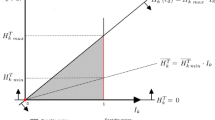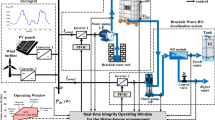Abstract
Quantifying excess energy using an energy balance model is the key to designing and operating an energy-efficient water distribution system (WDS). Excess energy, which can be recovered instantly or stored in a water-energy storage is the basis to estimate hydropower potential in the system. For a given WDS with its demand, how the excess energy can be managed efficiently to design a water-energy storage to maximize hydropower generation is the focus of this paper. A single-objective optimization model has been developed to optimize the dimensions for up to six water-energy storages for maximizing hydropower generation while minimizing the pumping energy. While the ratio of total energy recovered to total pumping energy is found to be about 40% for all water-energy configurations, the recovered specific energy ranges from 0.116 kWh/m3 to 0.121 kWh/m3 showing the potential use of WDS as an energy storage. Results show that hydropower generation increases with the increase of number of storages up to a certain number representing the constraints of constant drinking water demand and storage dimensions. In-pipe turbines with pump operation for minimizing pumping energy can offer the optimal solution for WDS energy management. A higher number of storages with in-pipe turbines offers uniformity in pressure distribution resulting increase in system robustness.






Similar content being viewed by others
Change history
20 April 2020
The original version of this article unfortunately contains mistake introduced during the publishing process. The author name “M. Fayzul” should be deleted in the author group. The corrected author group is shown above.
References
Aubuchon CP, Roberson JA (2014) Evaluating the embedded energy in real water loss. J Am Water Works Assoc 2014(106):129–138
Batchabani E, Fuamba M (2014) Optimal tank Design in Water Distribution Networks: review of literature and perspectives. J. Water Resour. Plan. Manag., https://doi.org/10.1061/(ASCE)WR.1943-5452.0000256, 136-145
Berardi L, Simone A, Laucelli D, Giustolisi O (2017) Feasibility of mass balance approach to water distribution network model calibration. Procedia Eng 186:551–558
Bolognesi A, Bragalli C, Lenzi C, Artina S (2014) Energy efficiency optimization in water distribution systems. Procedia Eng., 70, https://doi.org/10.1016/j.proeng.2014.02.021, 181-190
Carravetta A, del Giudice G, Fecarotta O, Ramos H (2012) Energy production in water distribution networks: a PAT Design strategy. J. Water Resour. Manag., 26(13), https://doi.org/10.1007/s11269-012-0114-1, 3947-3959
Del Teso R, Gomez E, Estruch-Juan E, Cabrera E (2019) Topographic energy Management in Water Distribution Systems. Water resources management. doi.org/10.1007/s11269-019-02375-9. Volume 33(12), 4385–4400
ERSAR (2017) (2017) annual report on water and waste Services in Portugal. ERSAR (Portuguese Water and Waste Regulator), Lisbon
Eusuff M, Lansey K, Pasha F (2006) Shuffled Frog-Leaping Algorithm: A Memetic Meta-Heuristic for Discrete Optimization. Journal of Engineering Optimization 38(2):129–154
Fecarotta O, McNabola A (2017) Optimal location of pump as turbines (PATs) in water distribution networks to recover energy and reduce leakage. Water resources management 31(15):5043–5059. https://doi.org/10.1007/s11269-017-1795-2
Fontana N, Giugni M, Glielmo L, Marini G, Zollo R (2019) Operation of a prototype for real time control of pressure and hydropower generation in water distribution networks. Water resources management 33(2):697–712. https://doi.org/10.1007/s11269-018-2131-1
Giugni M, Fontana N, Ranucci A (2014) Optimal location of PRVs and turbines in water distribution systems. J. Water Resour. Plan. Manag., 140(9), https://doi.org/10.1061/(ASCE)WR.1943-5452.0000418, 06014004
Iglesias-Castelló M, Iglesias-Rey PL, Martinez-Solano FJ (2018) Potentially recoverable energy assessment in water distribution networks WDSA/CCWI Joint Conference Proceedings 2018
Jung D, Lansey KE, Choi YH, Kim JH (2015) Robustness-based optimal pump design and scheduling for water distribution systems. J. Hydroinf. 18(3):500–513. https://doi.org/10.2166/hydro.2015.091
Kang D, Lansey K (2012) Revisiting optimal water-distribution system design: issues and a heuristic hierarchical approach. J. Water Resour. Plan. Manag. 138(3):208–217. https://doi.org/10.1061/(ASCE)WR.1943-5452.0000165
Kurek W, Ostfeld A (2013) Multi-objective optimization of water quality, pumps operation, and storage sizing of water distribution systems. J Environ Manag 115:189–197
Lansey, Kevin (2012) "Sustainable, robust, resilient, water distribution systems." 14th Water Distribution Systems Analysis Conference 2012, WDSA 2012, September 24-27, 2012, Adelaide, SA, Australia
Lenzi C, Bragalli C, Bolognesi A, Artina S (2013) From energy balance to energy efficiency indicators including water losses. Water science and technology: water supply 13(4):889–895. https://doi.org/10.2166/ws.2013.103
Lisk B, Ely G, Bloetscher F (2012) Implementing renewable energy at water utilities; Case Studies. Water Research Foundation
McNabola A, Coughlan P, Williams A (2014) Energy recovery in the water industry: an assessment of the potential of micro-hydropower. Water environ. J. 28(2):294–304. https://doi.org/10.1111/wej.12046
Mamade A, Loureiro D, Alegre H, Covas D (2017) A comprehensive and well tested energy balance for water supply systems. Urban water J. 14(8):853–861. https://doi.org/10.1080/1573062X.2017.1279189
Mamade A, Loureiro D, Alegre H, Covas D (2018) Top-down and bottom-up approaches for water-energy balance in Portuguese supply systems. Water 10(5):577
Moosavian N, Jaefarzadeh MR (2014) Hydraulic analysis of water distribution network using shuffled complex evolution. J. Fluids, https://doi.org/10.1155/2014/979706, 12
Pasha MFK, Lansey K (2009) Water quality parameter estimation for water distribution systems. J Civ Eng Environ Syst 26(3):231–248
Pasha MFK, Lansey K (2012) Effect of data collection on the estimation of wall reaction coefficients for water distribution models. J Water Resources Planning and Management 138(6):614–623
Pasha MFK, Lansey K (2014) Strategies to develop warm solutions for real-time pump scheduling for water distribution systems. Water Resour. Manage. 28(12):3975–3987. https://doi.org/10.1007/s11269-014-0721-0
Porkumaran K, Tharu RP, Sukanya S, Elezabeth VV, Gowtham N (2017) Micro in-pipe hydro power plant for rural electrification using LabVIEW. 2017 international conference on innovations in green energy and healthcare technologies (IGEHT), https://doi.org/10.1109/IGEHT.2017.8094098, 1–5
Sambito M, Puleo V, Freni G (2015) Energy, water and environmental balance of a complex water supply system. WIT transactions on ecology and the environment, 200, https://doi.org/10.2495/WS150061, 67-77
Samora I, Manso P, Franca M, Schleiss A, Ramos H (2016) Energy recovery using micro-hydropower Technology in Water Supply Systems: the case study of the City of Fribourg. Water 8(8):344. https://doi.org/10.3390/w8080344
Silva F, Soares F, Andrade M, SantAna D (2017) Water efficiency indicators studies and energy applied to real water distribution system of south of Minas Gerais-Brazil. European Water Resources Association 58:505–512
Stokes CS, Maier HR, Simpson AR (2016) Effect of storage tank size on the minimization of water distribution system cost and greenhouse gas emissions while considering time-dependent emissions factors. J Water Resour Plan Manag. https://doi.org/10.1061/(ASCE)WR.1943-5452.0000582
Vamvakeridou-Lyroudia LS, Walters GA, Savic DA (2005) Fuzzy Multiobjective Optimization of Water Distribution Networks. J. Water Resour. Plan. Manag., https://doi.org/10.1061/(ASCE)0733-9496(2005)131:6(467), 467–476
Walski, T. (2016). Energy balance for a water distribution system. World Environmental and Water Resources Congress 2016
Acknowledgments
This manuscript has been co-authored by employees of the California State University Fresno and Oak Ridge National Laboratory, managed by UT Battelle LLC. This research was supported in part by an appointment to the HERE program at Oak Ridge National Laboratory.
Author information
Authors and Affiliations
Corresponding author
Additional information
Publisher’s Note
Springer Nature remains neutral with regard to jurisdictional claims in published maps and institutional affiliations.
This manuscript has been co-authored by employees of the California State University Fresno and Oak Ridge National Laboratory, managed by UT Battelle LLC. This research was supported in part by an appointment to the HERE program at Oak Ridge National Laboratory.
Rights and permissions
About this article
Cite this article
Pasha, M.F.K., Weathers, M. & Smith, B. Investigating Energy Flow in Water-Energy Storage for Hydropower Generation in Water Distribution Systems. Water Resour Manage 34, 1609–1622 (2020). https://doi.org/10.1007/s11269-020-02497-5
Received:
Accepted:
Published:
Issue Date:
DOI: https://doi.org/10.1007/s11269-020-02497-5




